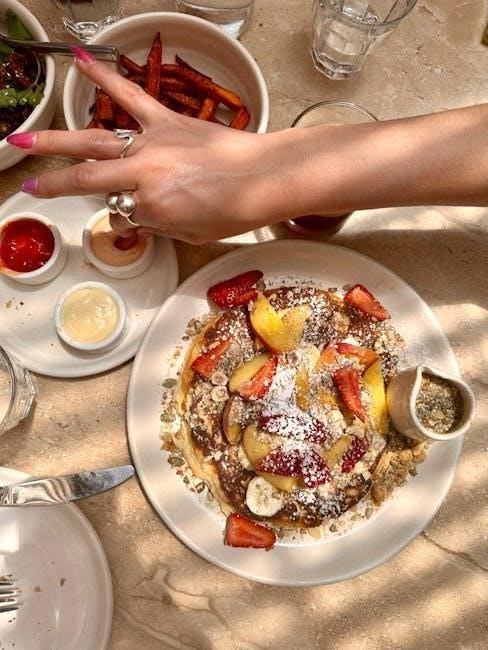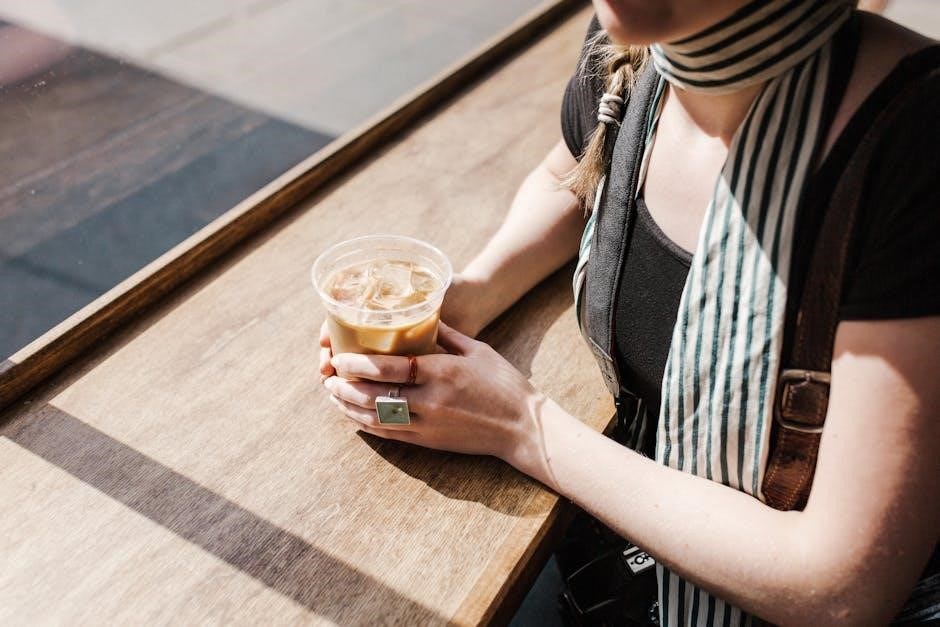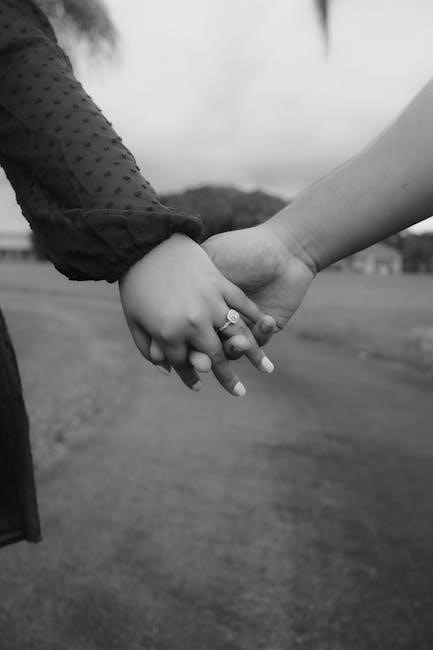The US Ring Size Guide provides a standardized system to determine ring sizes, ensuring a perfect fit for comfort and style. It uses circumference measurements and international conversions to help users find their ideal size. This guide is essential for both buyers and jewelers, offering clarity and consistency in ring sizing. Always consult a professional for accurate measurements.
1.1 Importance of Accurate Ring Sizing
Accurate ring sizing is crucial for both comfort and style, ensuring the ring fits perfectly without causing discomfort or restricting movement. Ill-fitting rings can lead to discomfort, difficulty in removal, or even damage to the ring itself. Proper sizing also ensures the ring stays in place securely, maintaining its aesthetic appeal. Factors like finger shape, knuckle size, and temperature can affect measurements, making precise sizing essential. Resizing can be costly and may alter the ring’s design, so getting it right the first time is key. Accurate sizing ensures longevity and satisfaction, making it a critical step in choosing the perfect ring;
1.2 Overview of US Ring Size System
The US Ring Size System is a standardized method used to determine ring sizes based on the inner circumference of the ring. It typically ranges from size 3 to 13.5, with half-size increments to ensure a precise fit. This system is widely used in the United States, Canada, and Mexico, and it is based on measuring the finger’s circumference in millimeters. The sizes correspond to specific diameters, making it easy to match the ring to the wearer’s finger. While other countries use different systems, the US system is straightforward and consistent, with printable charts and professional measurements available for accuracy.

Understanding US Ring Size Chart
The US Ring Size Chart is a standardized guide that matches finger circumference to ring sizes, ensuring a precise fit. It ranges from size 3 to 13.5, with half-size increments for accuracy. This chart helps buyers and jewelers determine the correct size efficiently, promoting comfort and style. Always consult a professional for the most accurate sizing.
2.1 How to Read a US Ring Size Chart
A US Ring Size Chart is a tool that helps determine the correct ring size by matching finger measurements to standard sizes. The chart typically includes columns for diameter (mm), circumference (mm), and corresponding US ring sizes. To use it, measure your finger’s circumference using a string or tape measure, then find the matching size on the chart. Sizes range from 3 to 13.5, with half-size increments for precision. Always ensure the measurement is taken comfortably, as tight or loose measurements can lead to incorrect sizing. For accuracy, use a printable guide or consult a professional jeweler.
2.2 Differences Between Men’s and Women’s Ring Sizes
Men’s and women’s ring sizes differ primarily due to average variations in finger size and circumference. Men typically have larger fingers, leading to larger ring sizes, often ranging from size 8 to 12 or more. Women’s sizes generally range from 4 to 9. These distinctions are based on standardized measurements, but individual variations are significant. The width of the ring band can also influence size selection, with men’s rings often having wider bands that may require a slightly larger size for comfort. Cultural preferences and personal fit choices further affect these differences, making it important to use standardized measurement tools or consult professionals for the best fit.
2.3 Printable US Ring Size Chart
A printable US ring size chart is an essential tool for determining your accurate ring size. It allows you to measure your finger circumference or compare an existing ring to the chart. The chart includes measurements in millimeters and corresponding US sizes, ensuring a precise fit. For best results, print the chart on standard paper and measure in the afternoon, as fingers tend to swell slightly. This method is particularly useful for online shopping or custom ring designs, helping you select the perfect size effortlessly. Using this guide ensures comfort and style, making it a valuable resource for anyone seeking the ideal ring fit.

Measuring Your Ring Finger
Measuring your ring finger accurately is crucial for the perfect fit. Use a string or tape measure, wrapping it comfortably around your finger, and record the circumference in millimeters. For best results, measure in the afternoon, as fingers tend to swell slightly during the day. Ensure the fit is not too tight or too loose to accommodate comfort and ease of removal. This simple process helps determine your ideal ring size, ensuring a comfortable and stylish wear.
3.1 Step-by-Step Guide to Measuring Your Finger
To measure your finger accurately, wrap a string or flexible tape measure around the base of your finger, ensuring it fits comfortably. Mark the overlapping point with a pen. Measure the length in millimeters using a ruler and compare it to the US ring size chart. For the best fit, measure at the end of the day when fingers are slightly larger. Avoid tight wrapping, as this can lead to an incorrect smaller size. Ensure the ring can slide over the knuckle easily. This method provides a reliable way to determine your ring size at home, ensuring a proper fit for your jewelry.
3.2 Using a String or Tape Measure
Measure your finger by wrapping a non-stretchable string or a flexible tape measure around the base. Mark where the string overlaps with a pen. Lay it flat and measure the length in millimeters using a ruler. Compare this to the US ring size chart to find your size. For accuracy, measure at the end of the day, as fingers tend to swell slightly. Ensure the string is not too tight or loose. This method is a practical way to determine your ring size without a professional sizer, providing a reliable guide for a comfortable fit.
3.3 Best Time of Day to Measure Finger Size
Measure your finger at the end of the day for the most accurate sizing, as fingers tend to swell slightly during the day. Avoid measuring when hands are cold, as this can cause fingers to shrink temporarily. Ideal times are late morning or early afternoon when fingers are at their average size. Consider temperature fluctuations, as heat causes swelling and cold causes constriction. For consistent results, measure under normal conditions to ensure the ring fits comfortably throughout the day. This ensures a proper fit, avoiding both tightness and looseness.

International Ring Size Conversion
Ring sizes vary globally, with the US, UK, and European systems differing significantly. Use conversion charts to match your size across regions, ensuring a perfect fit wherever you shop.
4.1 US vs. UK Ring Sizes
The US and UK ring size systems differ significantly. In the US, sizes are based on circumference measurements, while the UK uses a letter-based system. For example, a US size 6 corresponds to a UK size L. Understanding these differences is crucial for international shopping. Always refer to a conversion chart to ensure accuracy. This guide helps you navigate these variations, making it easier to find the perfect fit across borders.
4.2 US vs. European Ring Sizes
The US and European ring size systems differ significantly. In Europe, sizes are often based on the inner diameter of the ring, measured in millimeters, while the US system uses a numerical scale with half and quarter sizes. For example, a European size 52 corresponds to a US size 6. This difference can lead to confusion when shopping internationally. Always use a conversion chart to ensure accuracy. European sizes are commonly used in countries like Germany, Switzerland, and France. Proper conversion is essential for a perfect fit, so consult a professional or use a reliable sizing tool.
4.3 US vs. Japanese and Chinese Ring Sizes
The Japanese and Chinese ring size systems differ from the US system, as they are based on the inner diameter of the ring, measured in millimeters. For example, a US size 6 corresponds to a 16mm diameter in these systems. Japan, China, and Hong Kong follow this metric-based approach, while the US uses a numerical scale with half and quarter sizes. This discrepancy can lead to confusion when shopping internationally. To ensure accuracy, use a reliable conversion chart or consult a jeweler. Proper sizing is crucial for comfort and fit, so always double-check measurements before making a purchase.
Comfort Fit vs. Standard Fit Rings
Comfort Fit rings are designed with a thicker inner band for enhanced wearability, while Standard Fit rings have a uniform thickness. This difference impacts sizing accuracy and comfort.
5.1 What is Comfort Fit?
Comfort Fit rings feature a thicker, rounded inner band for enhanced wearability. Designed for ease, they are ideal for individuals with larger knuckles or those preferring a more spacious fit. Unlike standard fit rings, comfort fit styles prioritize comfort without sacrificing style. They are often recommended for everyday wear, as they reduce pressure on the finger. When sizing, comfort fit rings may require a slightly smaller size to ensure proper fit. This design is particularly popular in wedding bands and engagement rings for long-term wear. Always consult a professional to determine the perfect size for comfort fit rings.
5.2 Differences in Sizing for Comfort Fit Rings
Comfort Fit rings have a thicker, rounded inner band, which provides a looser fit compared to standard rings. This design requires sizing adjustments, as the inner diameter is slightly larger. For example, a size 6 in a standard ring might fit as a size 5.5 in a comfort fit due to the added comfort layer. Jewelers often recommend sizing down by half a size for comfort fit rings to ensure proper fit. The thicker band accommodates larger knuckles and provides ease of movement, making it ideal for everyday wear. Professional sizing is recommended to achieve the perfect balance between comfort and fit.

Factors Affecting Ring Size
Finger shape, knuckle size, and temperature fluctuations significantly impact ring fit. Weight changes and time of day also affect sizing, making accurate measurements essential for the perfect fit.
6.1 How Finger Shape and Knuckle Size Impact Fit
Finger shape and knuckle size play a significant role in determining the perfect ring fit. For individuals with slender fingers, a slightly smaller size may be appropriate, while thicker fingers or larger knuckles often require a larger size to ensure comfort. The ring must pass comfortably over the knuckle but fit snugly on the base of the finger. Variations in finger shape, such as tapered or stubby fingers, can also influence sizing. Accurate measurements are essential to balance aesthetics and comfort, ensuring the ring stays in place without causing discomfort.
6.2 Temperature and Its Effect on Finger Size
Temperature fluctuations can significantly impact finger size, affecting ring fit. In warmer conditions, fingers tend to swell, potentially requiring a slightly larger ring size. Conversely, in colder temperatures, fingers may shrink, making the same ring feel looser. This natural variation highlights the importance of measuring finger size at a neutral temperature for accuracy. For the best fit, consider the time of day and environmental conditions when sizing. Using a ring size chart or professional measurement during average temperature conditions ensures a more consistent and comfortable fit throughout the year.
6.3 Weight Fluctuations and Ring Fit
Weight changes can affect ring fit, as fluctuations impact finger size. Gaining weight may cause fingers to swell, making rings feel tighter, while weight loss can result in a looser fit. This variability emphasizes the importance of monitoring ring comfort during significant weight changes. Rings with adjustable bands or comfort-fit designs can accommodate minor size changes. For substantial weight fluctuations, resizing the ring or consulting a jeweler may be necessary to ensure optimal fit and comfort. Regularly checking the fit helps maintain both functionality and style of the ring.

Using a Printable Ring Sizer
A printable ring sizer is a convenient tool for measuring finger size at home. Simply print the guide, compare your ring or measure your finger, and ensure accuracy for the perfect fit.
7.1 How to Use a Printable Ring Size Chart
To use a printable ring size chart, start by printing the guide on standard paper. Ensure the scale is accurate by measuring the inchmarks with a ruler. Wrap a string or tape measure around your finger, noting the circumference. Compare this measurement to the chart to find your corresponding US ring size. For greater precision, measure at the end of the day when fingers are largest. This method is ideal for those wanting to measure discreetly at home, ensuring a proper fit without professional assistance.
7.2 Ensuring Accuracy with a Printable Guide
For precise results, print the ring size chart on standard paper and verify the scale with a ruler. Wrap a string or tape measure snugly around your finger, marking the overlap point. Measure this length in millimeters and compare it to the chart. Ensure the ring can slide over the knuckle comfortably. Factors like finger shape and temperature can affect size, so measure at the end of the day when fingers are largest. Double-checking with a professional jeweler is recommended for optimal accuracy, especially for comfort-fit styles. This ensures the perfect balance of comfort and style.

Professional Ring Sizing
Professional jewelers use precise tools like mandrels and sizing gauges to ensure accurate measurements. They consider factors like finger shape, knuckle size, and desired fit for optimal comfort and style.
8.1 Benefits of Getting Sized by a Jeweler
Consulting a professional jeweler ensures precise measurements tailored to your unique finger shape and knuckle size. They use specialized tools like mandrels and sizing gauges for accuracy. Jewelers account for factors like comfort fit preferences and temperature variations, which can affect finger size. Their expertise minimizes sizing errors, ensuring the ring slides on easily and stays in place without discomfort. This personalized approach guarantees a perfect fit, making it especially valuable for significant purchases like engagement or wedding rings. Professional sizing also eliminates guesswork, providing peace of mind and long-term satisfaction with your jewelry investment.
8.2 How Jewelers Measure Ring Size
Jewelers use precise tools like mandrels and ring sizing gauges to measure finger circumference and match it to standard US ring sizes. They slide the ring onto a tapered mandrel to determine its internal diameter. For direct finger measurement, a sizing gauge with numbered slots is used to find the best fit. Jewelers consider factors like knuckle size and comfort preferences to ensure accuracy. Their expertise ensures the ring fits comfortably, neither too tight nor too loose, and accounts for variations like temperature-related finger swelling. This professional method guarantees a precise and reliable sizing experience.

Ring Size and Material
Different materials, like gold, platinum, or silicone, affect ring fit. Thicker metals may require a slightly larger size for comfort, while resizable options offer flexibility. Always consider durability and personal preferences when choosing materials to ensure the best fit and style.
9.1 How Different Metals Affect Fit
Different metals can influence how a ring fits due to variations in thickness, density, and malleability. For instance, thicker metals like platinum may require a slightly larger size for comfort, while thinner metals like gold might fit differently. Comfort-fit rings, often made from materials like tungsten carbide, are designed with a wider inner band for ease. Resizable rings, typically made from gold or silver, offer flexibility. However, harder metals like titanium are less resizable, emphasizing the importance of accurate sizing. Always consider the metal’s properties and consult a jeweler for the best fit.
9.2 Ring Styles and Their Impact on Sizing
Ring styles significantly impact sizing due to design elements. Wide bands may require a larger size for comfort, while thinner styles fit more snugly. Engagement rings with bulky settings need careful measurement to ensure the band fits around the finger without discomfort. Adjustable rings offer flexibility but may not provide a precise fit. Additionally, rings with intricate details or engravings can affect how the ring sits on the finger. It’s crucial to consider the style when measuring to ensure the ring is both comfortable and visually appealing. Always try on similar styles before finalizing a size for the best fit.

Tips for Choosing the Right Ring Size
Measure your finger at a stable time of day, avoid guessing, and use a printable guide for accuracy. Consider weight fluctuations and knuckle size when selecting your size.
10.1 Considering the Ring’s Purpose (Engagement, Fashion, etc.)
When choosing a ring, its purpose greatly influences sizing decisions. Engagement rings require a snug fit to secure the gemstone, while fashion rings may allow for a looser style. Wedding bands should prioritize comfort for daily wear. Consider whether the ring will be worn alone or with others, as stacking can affect fit. For active lifestyles, a slightly tighter size might be preferable. Smart rings, like the Samsung Galaxy Ring, follow standard US sizing but may require additional considerations due to their unique design. Always think about the ring’s intended use and the wearer’s lifestyle to ensure the perfect fit.
10.2 How to Measure Discreetly for a Surprise Gift
Measuring ring size discreetly for a surprise gift requires creativity and subtlety. Borrow a ring they already own and compare it to a US ring size chart. Alternatively, observe their finger size when they’re relaxed, as fingers can swell or shrink throughout the day. You can also enlist a trusted friend or family member to provide insight. Use a printable ring size guide at home to measure a ring they’ve worn. For accuracy, avoid guessing and opt for methods that ensure a comfortable, proper fit without their knowledge.

Common Mistakes in Ring Sizing
Common mistakes include measuring too tight or loose, guessing sizes, and ignoring international size differences. Always use a US ring size chart for accuracy and proper fit.
11.1 Measuring Too Tight or Too Loose
One of the most common mistakes when determining ring size is measuring too tight or too loose. A ring that is too tight can restrict blood flow, while one that is too loose may slip off easily. Many people incorrectly wrap the string or tape measure too snugly or too loosely around their finger, leading to inaccurate results. To avoid this, ensure the string or tape measure is wrapped comfortably, allowing the ring to slide over the knuckle without difficulty. Measuring at the right time of day, when fingers are at their average size, also helps achieve a precise fit. Always double-check your measurements for accuracy.
11.2 Ignoring International Size Differences
Another common mistake is overlooking international ring size differences. Ring sizes vary significantly across countries, with the US, UK, Europe, and Japan each having their own systems. For instance, a size 6 in the US is not the same as a size 6 in the UK or Europe. Using a universal size chart without considering regional differences can lead to ordering the wrong size. To avoid this, always refer to an international conversion chart or consult a jeweler familiar with cross-country sizing. This ensures the ring fits perfectly, regardless of its origin or destination.
The US Ring Size Guide is essential for ensuring a perfect fit. Accurate measurements and professional consultations guarantee comfort and satisfaction. Always verify sizes before purchasing.
12.1 Final Tips for Ensuring the Perfect Fit
To ensure a perfect fit, measure your finger at the end of the day when it’s largest. Use a string or tape measure for accuracy, and consider factors like temperature and weight fluctuations. A snug but comfortable fit is ideal, allowing the ring to slide over the knuckle easily. If unsure, consult a professional jeweler for precise sizing. Remember, comfort fit rings may require a slightly larger size. Always double-check international size conversions and refer to a printable chart for guidance. Proper sizing ensures both comfort and style, making your ring-wearing experience enjoyable and hassle-free. Prioritize accuracy for the best results.
12.2 Encouraging Readers to Consult a Professional if Unsure
If you’re uncertain about your ring size, consulting a professional jeweler is highly recommended. Jewelers use precise tools and years of expertise to ensure an accurate fit. They can also guide you through international size conversions and comfort fit adjustments. A professional sizing guarantees comfort and style, eliminating the risk of a poor fit. Don’t hesitate to seek expert advice for a confident purchase. Their expertise ensures your ring will be both comfortable and flattering, making it a worthwhile investment for years to come. Professional sizing is the ultimate assurance of satisfaction.